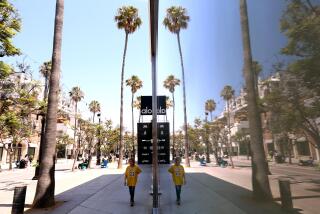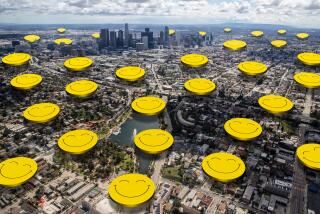WESTSIDE / COVER STORY : Getting Hip to the Strip : With Its Hundreds of Upscale Shops and Restaurants, Brentwood Has Become a Hot Spot While Businesses and Residents Struggle to Cope With New-Found Fame
The Simpson saga may have put Brentwood on national maps overnight, but the neighborhood had become a destination point for locals long before the media blitz.
Much of that local attention has centered on the San Vicente Boulevard strip, a half-mile stretch from Bundy Drive to Wilshire Boulevard lined with about 300 upscale shops and restaurants that have made the area one of the Westside’s most desirable social enclaves.
With its leafy coral trees dotting a grassy median, where years ago red street cars ran from Brentwood down to the ocean, business people have been drawn to a small-town atmosphere not easy to find in Los Angeles.
Officially known as the San Vicente Scenic Corridor, it has managed to thrive, mainly due to its array of restaurants, while neighboring Westwood Village, a trendy shopping and movie theater district that once drew throngs on weekend nights, has struggled in recent years--the victim, some say, of its own success.
“People are trying to recapture the magic that Westwood once had,” said Jack Kyser, chief economist for the Economic Development Corp. of Los Angeles County. “They’re looking for warm and fuzzy areas, and they seem to have found it in Brentwood.”
Real estate agents say San Vicente has become one of the top locations for retail and office projects on the Westside.
“It has the highest demand and the lowest vacancy rates,” said David Thind, a Brentwood-based broker who handles real estate across the city.
Business people are drawn to an area in large part due to its reputation for low-crime and high life.
The Simpson case notwithstanding, Brentwood has one of the lowest crime rates in the city, said Los Angeles Police Capt. Connie Dial, who heads patrols in the West Los Angeles area. The area also includes some of the city’s wealthiest residents, who live in some of the region’s priciest homes. Real estate brokers say the average price for single-family homes on the market is $1.4 million, with the average condo going for $280,950.
Restaurants have gained the most from San Vicente’s recent growth, with 50-minute waits for tables at most establishments on typical evenings. Restaurants account for about 10% of the commercial space on the strip.
Yet, while restaurants offering haute and lean cuisine have flourished, the smaller mom-and-pop businesses that lent the area a hometown feel have not been as successful of late. The recession has left an abundance of homes for sale on the shady side streets leading from the boulevard, meaning fewer residents for the businesses that cater to such traffic. In addition, the arrival of large chain stores has compounded trouble for some smaller shopkeepers.
Arian Moini, pharmacist at Westside Pharmacy since 1982, said the neighborhood drugstore has been struggling for business since a Long’s Drugs store moved in last year, less than half a mile away.
“We can blame it on the recession or on Long’s, but I think it’s got to do with a lot of people moving out of the neighborhood,” Moini said.
Nevertheless, other pedestrian traffic has surged since Nicole Brown Simpson, former wife of O.J. Simpson, and her friend Ronald Lyle Goldman were found murdered June 13 on the steps of her South Bundy Drive condo not far from the strip.
Much of the curiosity has centered on Mezzaluna, the San Vicente Boulevard restaurant where Goldman worked as a waiter and where Nicole Simpson dined the night before they both were killed. It now bulges with customers every night of the week.
Other establishments have experienced an uptick as well.
“There are a lot of tourists driving around,” said Dale Greenblatt, general manager of Gratis, one of the area’s newest restaurants. “The minute (O.J. Simpson) was caught, people showed up and the crowds picked up.”
*
San Vicente’s look, generally storefronts with conservative lettering and lighting with some sidewalk dining, is owed to two vigilant groups that guard against gaudy signs and other garish architectural features.
This is not a street where a McDonald’s would fit.
The two groups, the Design Review Board, whose members are chosen by Los Angeles City Councilman Marvin Braude, a Brentwood resident, and the Brentwood Homeowners Assn., make recommendations to the city Planning Department on prospective San Vicente businesses. The advice is usually heeded.
Together they have prevented tacky signs, unsightly buildings and other eyesores from cropping up on the boulevard.
“Low density, beauty and substantial public benefit, that’s what I’m concerned about,” Braude said.
After 29 years in office, Braude’s influence is apparent. San Vicente merchants recall how he helped persuade his City Council colleagues in 1992 to exempt Brentwood from an ordinance that created mandatory no-parking tow-away zones during the evening rush hour along most of the area’s most heavily traveled streets.
Business owners complained that the no-parking ordinance was forcing customers away, and now the strip is one of the only streets in the city where the tow-away zones are not in effect.
Every aesthetic aspect of San Vicente, from shrub heights to parking requirements, are detailed in a design plan that is largely Braude’s handiwork. In the early 1980s, he appointed the Design Review Board, the city’s first, to ensure that new businesses would comply with the plan’s requirements.
The seven board members evaluate proposals from prospective San Vicente businesses with this mission: to promote pedestrian traffic along San Vicente and “to keep the look of San Vicente from going in another direction,” said Braude aide Daniel Kahn.
Although Angeleinos may be touched by the San Vicente strip’s hometown appeal, longtime residents reminisce about the days when it had an even more profound community spirit.
The crowds, it seems, have been a mixed blessing. While it has meant profits for some upscale businesses, it has also diminished the Main Street aura, some say, and has lead to parking problems that could threaten its success.
“San Vicente isn’t the village that it was,” said Jules Lamm, an optometrist who has had his practice on San Vicente for more than 40 years.
There were always restaurants and shops on the strip, Lamm said, but San Vicente has never been as crowded as it is today. And chain stores and other new arrivals have ousted mom-and-pop shops in recent years: Gone are a popular hobby shop, shoe store and neighborhood eatery--replaced by a gym, Music Plus record store and the Cheesecake Factory.
*
Still, the businesses come.
“We explored other possible locations on the Westside--Marina del Rey, Beverly Hills, Sepulveda (Boulevard) and Santa Monica to name a few, but we really wanted to be here,” said Jason McKinley, who owns Great Harvest Bread Co. with his wife, Gina. It opened in June. “There’s a real sense of community. You don’t get that much in L.A.”
Said Linda Cadioty, senior vice president of the Cheesecake Factory, which opened an outlet in April, 1993: “We looked in Brentwood for a long time, but earlier we (were concerned) it was too close to our locations in Beverly Hills and Marina del Rey. Once those were established, we decided to open in Brentwood. It’s such a small, sweet area.”
Most of San Vicente’s restaurateurs seem untouched by competition.
“Everyone seems to be doing just fine,” said Gratis’ Greenblatt. “There’s enough people to go around.”
There has been some restraint to the growth.
Limiting the number of restaurants that serve alcohol on the strip is a persistent and sometimes heated issue for Braude’s office. The city does not specify the number of liquor licenses that can be issued on San Vicente, but Braude focuses on keeping the concerns of neighbors in mind.
“I am well-known for my skeptical view of liquor licenses,” Braude said. “If it is the type of place that just serves liquor, then I would be opposed to it.”
Said Michael Harris, president of the Brentwood Homeowners Assn., which has lobbied against liquor licenses: “It would be difficult to open a bar. This has been an ongoing battle.”
The city Planning Department recently denied conditional-use permits to two restaurants, Johnny Rockets and Taiki, that would have allowed them to sell alcohol. The department’s staff report cited the high concentration of liquor licenses in the area as the reason for the rejections. The City Council will now review the case.
Even more divisive than the issue of liquor licenses is the area’s parking problem: there are simply not enough spaces.
“Yesterday I saw two women get out of their cars and start beating each other up over a parking space,” said Bucholtz, manager of the restaurant Koo-Koo-Roo’s.
Longtime Brentwood residents recall that the parking problem was supposed to have been resolved by using revenue from meters along San Vicente to purchase off-street parking lots. But the city instead deposited the money into a general fund that it used for other purposes.
“The money is available, but we can’t find appropriate space in that area,” Braude said. No one wants to predict how long San Vicente will be hot. Angelenos tend to be fickle when it comes to patronizing the latest place to be seen.
“Throw anything into the pond that makes it change, then you risk not having the crowd,” said Stanley Kyker, executive vice president of the California Restaurant Assn. He cites Westwood as an example, noting that it seemed to lose its charm after being rocked by gang violence and crime several years ago.
“On San Vicente they’ll have to work with other retailers to market the area, to continue making it attractive,” Kyker said. “But the problem we have in Southern California is that an area becomes ‘in’ just because it’s ‘in.’ Nothing lasts forever.”
With Brentwood surrounded by some of the most attractive high-life restaurants and shops on the Westside, whose decor is strictly controlled by city groups, some are weary of losing the small-town atmosphere, as crowds flock to L.A.’s latest hot spot.
More to Read
Inside the business of entertainment
The Wide Shot brings you news, analysis and insights on everything from streaming wars to production — and what it all means for the future.
You may occasionally receive promotional content from the Los Angeles Times.










